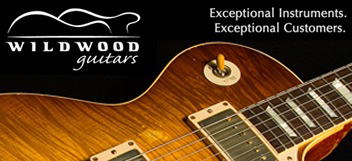You are using an out of date browser. It may not display this or other websites correctly.
You should upgrade or use an alternative browser.
You should upgrade or use an alternative browser.
What kind of mahogany is used in historics?
- Thread starter gnugear
- Start date
TomTaco
Member
- Joined
- Nov 9, 2003
- Messages
- 363
I think the standard is African, Honduran would be a special instrument and likely advertised as being Honduran (and a lot more $$). Not sure about Brazilian, I think they were used on some years, and designated as such by SN#, but I'm no expert.
Brownie
New member
- Joined
- Jul 12, 2003
- Messages
- 1,886
As far as I've ever known, Historic LPs are made with Honduran, or mahogany that comes from that region of the world. African mahogany is aka korina, and there are probably other varieties of African mahogany that don't have the characteristic color of korina. Korina would be a special order item, at a premium price. Good korina is quite scarce lately.
Aside from limited runs of brazilian, most of the production rosewood fretboards are Madagascar.
Aside from limited runs of brazilian, most of the production rosewood fretboards are Madagascar.
1954Gold
Active member
- Joined
- Nov 7, 2003
- Messages
- 1,889
My luthier told me my R7 was Honduran, which he said was the least expensive variety.
check item #7 in the FAQ on the CS site:
http://www.gibsoncustom.com/flash/products/faq/faq.html
http://www.gibsoncustom.com/flash/products/faq/faq.html
TM1
Well-known member
- Joined
- Jun 27, 2003
- Messages
- 8,356
That species of Mahogany comes from Peru & Central America.
les strat
New member
- Joined
- Aug 22, 2004
- Messages
- 5,194
So, if I have a guitar made from Honduran mahogany, the wood itself is worth a good bit even thought it's not a Gibson?
andreja marovic
New member
- Joined
- Jun 1, 2004
- Messages
- 2,688
I don't think so!les strat said:So, if I have a guitar made from Honduran mahogany, the wood itself is worth a good bit even thought it's not a Gibson?
Gibson is the name for the one we all pay the extra $$$.
And Henry knows it well!
GeetarGoul
Active member
- Joined
- Jul 25, 2001
- Messages
- 5,044
http://www2.fpl.fs.fed.us/TechSheets/Chudnoff/TropAmerican/html_files/swiete1new.html
Swietenia macrophylla
Family: Meliaceae
Honduras Mahogany
Caoba
Other Common Names: Caoba (throughout Latin America), Acajou (French-speaking areas).
Distribution: Southern Mexico southward to Colombia, Venezuela, and parts of the upper Amazon and its tributaries in Peru, Bolivia, and Brazil. Plantations have been established within its natural range and elsewhere.
The Tree: Sometimes 150 ft in height and 6 ft and more in diameter above the heavy buttresses; boles are clear from 60 to 80 ft.
The Wood:
General Characteristics: Heartwood reddish, pinkish, salmon colored, or yellowish when fresh; deepening with age to deep rich red or brown; distinct from the yellowish or whitish sapwood. Luster high and golden; texture rather fine to coarse; grain straight to roey, wavy, or curly, often with an attractive figure; odor and taste not distinctive.
Swietenia macrophylla
Family: Meliaceae
Honduras Mahogany
Caoba
Other Common Names: Caoba (throughout Latin America), Acajou (French-speaking areas).
Distribution: Southern Mexico southward to Colombia, Venezuela, and parts of the upper Amazon and its tributaries in Peru, Bolivia, and Brazil. Plantations have been established within its natural range and elsewhere.
The Tree: Sometimes 150 ft in height and 6 ft and more in diameter above the heavy buttresses; boles are clear from 60 to 80 ft.
The Wood:
General Characteristics: Heartwood reddish, pinkish, salmon colored, or yellowish when fresh; deepening with age to deep rich red or brown; distinct from the yellowish or whitish sapwood. Luster high and golden; texture rather fine to coarse; grain straight to roey, wavy, or curly, often with an attractive figure; odor and taste not distinctive.
535faultless
New member
- Joined
- Feb 14, 2002
- Messages
- 1,644
My luthier told me my R7 was Honduran, which he said was the least expensive variety.
Honduras mahogany is definately NOT the cheapest mahogany out there. If it was, every Epiphone would be made out of it.
GeetarGoul
Active member
- Joined
- Jul 25, 2001
- Messages
- 5,044
I'm reading deeper and I guess the mahogany used in the 50's was indeed different! They currently use Swietenia macrophylla
They used to use: Swietenia Humilis
Honduran Mahogany S. humilis and Caribbean Mahogany S. mahagoni, which once supplied mahogany markets, are both are considered commercially extinct throughout much of their ranges. Increased action is required to ensure that S. macrophylla does not suffer the same fate.
They used to use: Swietenia Humilis
Honduran Mahogany S. humilis and Caribbean Mahogany S. mahagoni, which once supplied mahogany markets, are both are considered commercially extinct throughout much of their ranges. Increased action is required to ensure that S. macrophylla does not suffer the same fate.
55Custom
New member
- Joined
- Sep 5, 2003
- Messages
- 6,251
So that means they used Swietenia Humilis prior to the Late 80's? and going back through the Norlin era to the '50's?GeetarGoul said:They used to use: Swietenia Humilis
Honduran Mahogany S. humilis and Caribbean Mahogany S. mahagoni, which once supplied mahogany markets, are both are considered commercially extinct .
GeetarGoul
Active member
- Joined
- Jul 25, 2001
- Messages
- 5,044
55Custom- That would be my guess. With the selection of better/larger/older/lighter S. Humilis being more available the earlier you go. By the late sixties and early seventies, I'm guessing most of the good S. Humilis trees were gone. Which would maybe explain why 50's and early 60's Gibsons consistantly sound so good. It was probably harder and better stuff. They knew this and went for it first. ?
Articles say that basically S. Humilis was totally mismanaged and ALL of the DNA from the good large trees is basically gone. :toobad
Articles say that basically S. Humilis was totally mismanaged and ALL of the DNA from the good large trees is basically gone. :toobad
55Custom
New member
- Joined
- Sep 5, 2003
- Messages
- 6,251
How did you find out they used S. Humilis? And is that the original wood they called "Honduran Mahogany"?
I didn't know about S. Humilis. This changes a few things considerably. It also clarifies what I found regarding use of old mahogany on new LP's versus the old LP's, that while both groups use old mahogany, they are different. I thought the differences were just because of local botanical environments, but a different species - that takes it a step further, if true.
I didn't know about S. Humilis. This changes a few things considerably. It also clarifies what I found regarding use of old mahogany on new LP's versus the old LP's, that while both groups use old mahogany, they are different. I thought the differences were just because of local botanical environments, but a different species - that takes it a step further, if true.
Progrocker111
Well-known member
- Joined
- Dec 10, 2003
- Messages
- 4,013
Was the mahogany used in 70s the same type like in 50s and 60s, only lower grade?
GeetarGoul
Active member
- Joined
- Jul 25, 2001
- Messages
- 5,044
http://www.traffic.org/mahogany/cites.html
Long renowned for its beauty and durability, Big-leafed Mahogany Swietenia macrophylla is currently the most commercially important of the American mahoganies. Exploitation of S. macrophylla has shifted among range States as wild stocks have declined. S. macrophylla populations in Mesoamerica are now largely depleted, the South American countries of Bolivia, Brazil and Peru now supplying the majority of mahogany in trade. Honduran Mahogany S. humilis and Caribbean Mahogany S. mahagoni, which once supplied mahogany markets, are both are considered commercially extinct throughout much of their ranges. Increased action is required to ensure that S. macrophylla does not suffer the same fate.
Long renowned for its beauty and durability, Big-leafed Mahogany Swietenia macrophylla is currently the most commercially important of the American mahoganies. Exploitation of S. macrophylla has shifted among range States as wild stocks have declined. S. macrophylla populations in Mesoamerica are now largely depleted, the South American countries of Bolivia, Brazil and Peru now supplying the majority of mahogany in trade. Honduran Mahogany S. humilis and Caribbean Mahogany S. mahagoni, which once supplied mahogany markets, are both are considered commercially extinct throughout much of their ranges. Increased action is required to ensure that S. macrophylla does not suffer the same fate.
GeetarGoul
Active member
- Joined
- Jul 25, 2001
- Messages
- 5,044
South American Mahogany = Swietenia macrophylla
Central American Mahogany aka Honduran = Swietenia Humilis
The wood is different and is from a different part of the world. i did not know this until today.
Central American Mahogany aka Honduran = Swietenia Humilis
The wood is different and is from a different part of the world. i did not know this until today.
55Custom
New member
- Joined
- Sep 5, 2003
- Messages
- 6,251
Excellent find, GeetarGoul. :yay
Here's info from another site. (So much for the virgin forest theory .....)
"The history of mahogany logging is also a history of deforestation in the Caribbean and Central and South America. The wave of logging that began in the 1500s and has expanded out from the original point of European invasion of the Americas and continues to this day is nearly identical to the expansion of the mahogany frontier.
Swietenia humilis, known as Honduran mahogany, is found on the Pacific coastal region of Central America. Both of these species are listed under the Convention on Trade in Endangered Species known as CITES which means that countries trading in this species need to verify that sources are legal and sustainable."
S. Humilis was listed on the CITES list on July 1, 1975. Interesting that Gibson went to maple necks right at that time. Coincidence? :hmm
Here's info from another site. (So much for the virgin forest theory .....)
"The history of mahogany logging is also a history of deforestation in the Caribbean and Central and South America. The wave of logging that began in the 1500s and has expanded out from the original point of European invasion of the Americas and continues to this day is nearly identical to the expansion of the mahogany frontier.
Swietenia humilis, known as Honduran mahogany, is found on the Pacific coastal region of Central America. Both of these species are listed under the Convention on Trade in Endangered Species known as CITES which means that countries trading in this species need to verify that sources are legal and sustainable."
S. Humilis was listed on the CITES list on July 1, 1975. Interesting that Gibson went to maple necks right at that time. Coincidence? :hmm
BobbyS
New member
- Joined
- Oct 9, 2001
- Messages
- 761
I was told years ago by a well known luthier that my 52 goldtop was made out of Cuban Mahogany. Dunno if that's true but I do know that Cuban mahogany (and other central american mahogany) is very difficult to obtain now and if you do find some is very expensive. Korina is not the same as so called African mahogany. African mahogany is not Swietenia at all (nor is Korina which is also called Lemba if I remember correctly).
Interestingly, some wood experts claim that pre world war two Gibsons sometimes used African mahogany.
Interestingly, some wood experts claim that pre world war two Gibsons sometimes used African mahogany.



